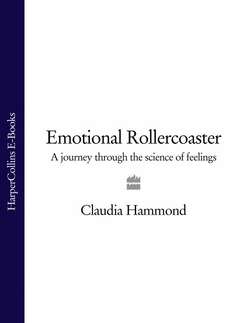Читать книгу Emotional Rollercoaster: A Journey Through the Science of Feelings - Claudia Hammond - Страница 19
the sad mind and the sad body
ОглавлениеThree years ago Julia wheeled her trolley past an empty customs desk. Her trip to Vietnam had been fantastic and as usual when she was tanned and rested, she felt great. Wouldn’t it be nice if someone had come to meet her? To her surprise she saw that someone had. Her sister’s boyfriend was leaning grimly on the barrier, but it wasn’t nice at all. Why was he here? What had gone wrong? Had her mother’s cancer come back? No, it wasn’t that. He told her that everyone was safe, but that her parents’ thatched cottage in Suffolk had burnt down. Julia was devastated. ‘It was a 400-year-old cottage and my dad had lived there since he was ten. When I got back to my sister’s house she showed me the front page of the local paper and there was a picture of my dad who’s an artist, holding one of his pictures with the headline, “Artist Loses Life’s Work” and he was crying. It felt as though I were looking at a newspaper that had been used as a prop in a film. I kept thinking that my kids will never see the house where I grew up. I think when sadness is at its worst you wake up and for five seconds you think everything’s OK and then you have this sudden shock that something’s happened. It’s almost like someone’s pressing an iron bar down on your chest. True sadness to me is like a physical pain. My heart actually hurt for weeks and weeks.’
It is true that sadness has physical effects on the body. Skin conductance, associated with sweating, increases and even intestinal processes can change. A patient called Tom, from a case study in 1943, had a stomach which became pale whenever he was depressed and, back in the 1920s, it was found during other research that depressed patients secreted less gastric acid into their stomachs than usual. There are also hormonal differences between the depressed and the non-depressed. About half of those with depression seem to have abnormally high blood levels of the hormone Cortisol which is released during times of stress under the control of a brain system called the HPA axis. This causes a cascade of chemical reactions. A small area of the brain called the hypothalamus (H) organises activities such as sex-drive and the control of body temperature. It releases a hormone which affects the pituitary gland (P) which in turn causes the adrenal glands (A) above the kidneys, to produce the stress hormone Cortisol, hence the name HPA axis. Crucially, for some people this control system doesn’t seem to work, resulting in an excess of Cortisol.
Naturally the main organ affected by sadness is the brain. There are changes in the levels of neurotransmitters or chemical messengers which communicate between the millions of neurons in the brain in a kind of relay race. One of the most important is serotonin which is ejected in a burst every millisecond and seems to have an involvement in almost everything that happens in the brain, without having the sole responsibility for any single function. When we feel depressed serotonin levels are lower. This is the basis on which anti-depressants like Prozac work. Prozac is an SSRI or selective serotonin reuptake inhibitor. Normally when serotonin is squirted out of the nerve ending it acts on receptors in the brain and if too much is released it’s taken back up into the nerve endings so that it can be recycled. The idea of drugs like SSRIs is to block this process, so that instead of being taken back up, the serotonin can spend longer in contact with the receptor and have more of an effect on mood. The effect, however, is far from immediate. When Julia took Prozac when she was depressed it was a few weeks before she noticed a difference. ‘You take it for a few days and you wonder why you’re bothering because you still feel terrible. Then very gradually it starts to work. It’s not as though you suddenly feel high or happy; it’s more as though your real self has been covered up and something in the tablets uncovers it and lets you be yourself again.’
If SSRIs can increase the amount of serotonin which is active in the brain and serotonin can make you feel happier, then it should follow that we could all feel more cheerful if we took an SSRI. However, in a non-depressed person these drugs have no effect on mood because of the way that serotonin operates in the brain. It’s not like dopamine, the neurotransmitter which causes us to feel joyful. If you are not depressed then SSRIs make no difference to the way you feel. In fact, even lowering your levels of serotonin artificially leaves your mood constant if there is no history of depression in yourself or your family, suggesting that a vulnerability to depression is the key. If you have had depression before and your serotonin levels are lowered medically then you will feel depressed once again. For some reason studies have found that women’s serotonin levels are easier to lower artificially, while men’s brains appear to be better able to compensate for these chemical changes induced in a lab. Phil Cowen, a psychopharmacology professor at Oxford University who has worked on SSRIs for several years, described this phenomenon as a little like a scar. Once you’ve had depression the scar remains. Somehow those pathways in the brain have been disrupted. It’s also complicated by a natural variation in the number of receptors for serotonin that each person has. It can only have an effect if there are receptors to receive it.
